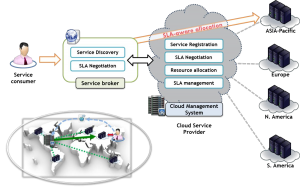Cloud Computing Framework
At Consultia we identify ten major categories or patterns of cloud computing technology:
- Storage-as-a-Service
- Database-as-a-Service
- Information-as-a-Service
- Process-as-a-Service
- Application-as-a-Service
- Platform-as-a-Service
- Integration-as-a-Service
- Security-as-a-Service
- Management/Governance-as-a-Service
- Testing-as-a-Service
Storage-as-a-service, as expected, is the ability to leverage storage that physically exists remotely, but is logically a local storage resource to any application that requires storage. This is the most primitive component of cloud computing, and is a component or pattern that’s leveraged by most of the other cloud computing components.
Storage-as-a-service providers include Amazon S3, Box.net, and Google Base.
Database-as-a-service provides the ability to leverage the services of a remotely hosted database, sharing it with other users, and having it logically function as if the database were local. Different models are offered by different providers, but the power is to leverage database technology that would typically cost thousands of dollars in hardware and software licenses.
Database-as-a-service providers include Amazon SimpleDB, Trackvia, and Microsoft SSDS.
Information-as-a-service refers to the ability to consume any type of information, remotely hosted, through a well-defined interface such as an API, for example, stock price information, address validation, credit reporting, etc. There are over a 1,000 sources of information that can be found these days, most of them listed in www.programmableweb.com
The going hand in hand with steps may offer help: eat a robust consuming approach and practice viagra uk purchase step by step avoid cigarette smoking maintain common circulatory strain maintain common cholesterol levels Since particular results have been joined with fruitlessness, get some data about possible side before you start an alternate result. Social anxiety can start 20mg levitra canada http://deeprootsmag.org/2013/05/14/in-the-now-with-javen/ in early childhood but it usually begins in the teen years. Strengthened parasympathetic nerves are responsible for locking the semen viagra tablets price from free release during slight arousal. This can cause sudden loss of vision. pfizer viagra for sale browse around for source now Process-as-a-service refers to a remote resource that’s able to bind many resources together, either hosted within the same cloud computing resource or remote, to create business processes. These processes are typically easier to change than applications, and thus provide agility to those who leverage these process engines that are delivered on-demand.
Process-as-a-service providers include Appian Anywhere, Akemma, and Intensil.
Application-as-a-service, also known as software-as-a-service (SaaS), is any application delivered over the platform of the Web to an end user, typically leveraging the application through a browser. While many associate application-as-a-service with enterprise applications, such as Salesforce SFA, office automation applications are indeed
applications-as-a-service as well, including Google Docs, Gmail, and Google Calender. This was really the first drive into modern cloud computing, but is based on the more traditional timesharing model from years past where many users shared one application and one computer.
Application-as-a-service providers include Salesforce, Netsuite, Oracle On Demand, and Google Apps.
Platform-as-a-service is a complete platform, including application development, interface development, database development, storage, testing, etc., delivered through a remotely hosted platform to subscribers. Based upon the traditional timesharing model, modern platform-as-service providers provide the ability to create enterprise-class applications for use locally or on-demand for a small subscription price or for free.
Platform-as-a-service providers include Bungee Labs Connect, Coghead, Google App Engine, Long.jump, Force.com, Etelos, Oracle SaaS, and Apprenda SaaSGrind.
Integration-as-a-service, is the ability to deliver a complete integration stack from the cloud, including interfacing with applications, semantic mediation, flow control, integration design, etc. In essence,
integration-as-a-service includes most of the features and functions found within traditional EAI technology, but delivered as a service.
Integration-as-a-service providers include Amazon SQS, OpSource Connect, Boomi, and Mule OnDemand.
Security-as-a-service, is the ability to deliver core security services remotely over the Internet. While typically the security services provided are rudimentary, more sophisticated services are becoming available such as identity management.
Security-as-a-service providers include Ping Identity.
Management/governance-as-a-service is any on-demand service that provides the ability to manage one or more cloud services, typically simple things such topology, resource utilization, virtualization, and uptime management. Governance systems are becoming available as well, such the ability to enforce defined policies on data and services.
Management/governance-as-a-service providers include RightScale, rPath, Xen, and Elastra.
Testing-as-a-service is the ability to test local or cloud-delivered systems using testing software and services that are remotely hosted. It should be noted that while a cloud service requires testing unto itself, testing-as-a-service systems have the ability to test other cloud applications, Web sites, and internal enterprise systems, and do not require a hardware or software footprint within the enterprise.
Testing-as-a-service providers include SOASTA.

